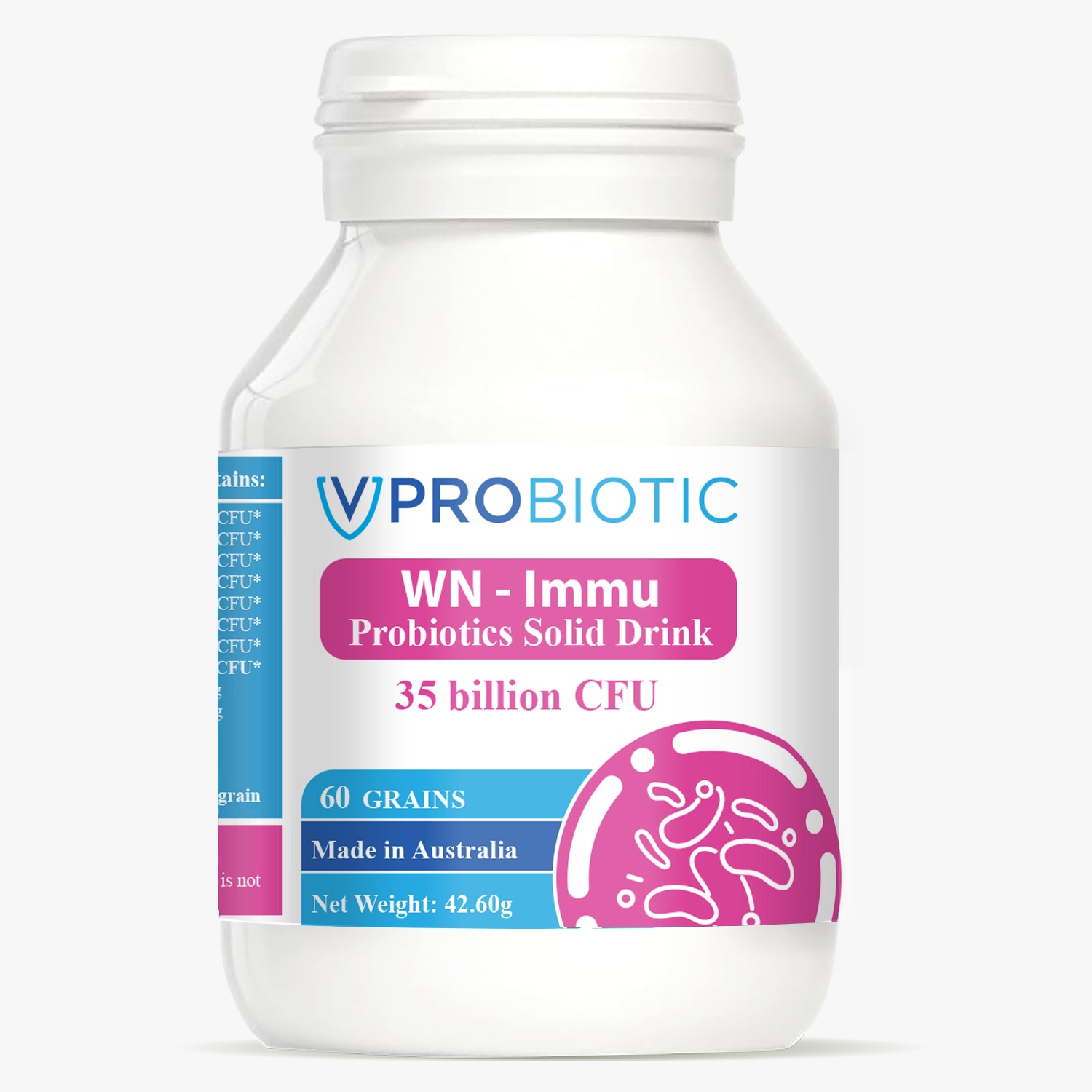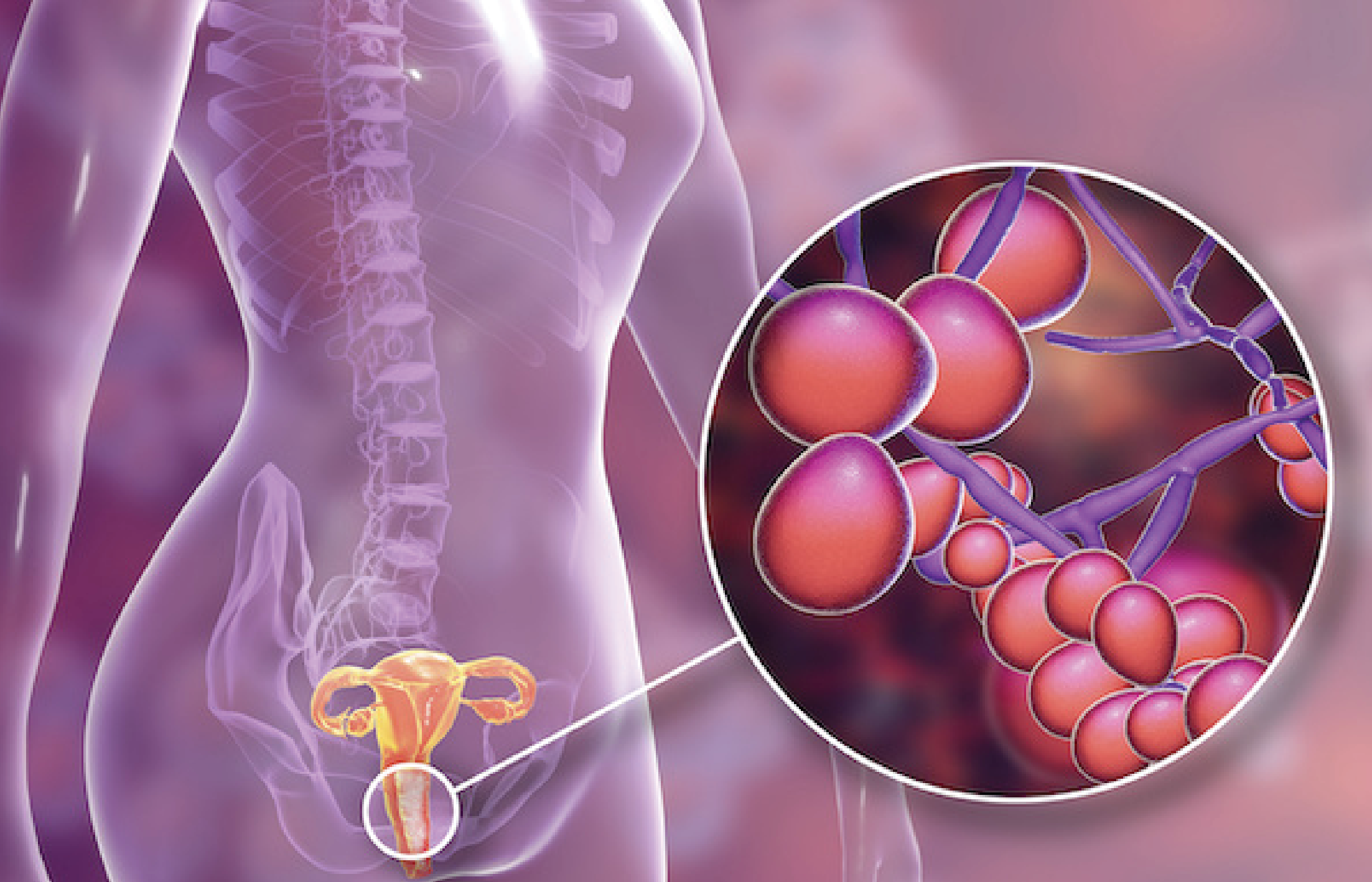
WN-IMMU
PROBIOTICS CAPSULES
30s/60s
A premium, targeted probiotic formula containing 7 strains of beneficial bacteria. The use of probiotics can improve vaginal flora, increase beneficial bacteria, reduce the number of harmful bacteria, and further maintain the stability of vaginal flora environment. Nowadays, there is increasing evidence that probiotics are effective in the treatment of BV.
INGREDIENTS
| Each grain contains: | |
| Lactobacillus acidophilus | 9 billion CFU* |
| Lactobacillus delbrueckii subsp. Bulgaricus | 3 billion CFU* |
| Lactobacillus gasseri | 5 billion CFU* |
| Lactobacillus paracasei | 4 billion CFU* |
| Lactobacillus plantarum | 5 billion CFU* |
| Lactobacillus reuteri | 5 billion CFU* |
| Lactobacillus rhamnosus | 4 billion CFU* |
| Total | 35 billion CFU* |
| Cranberry powder | 290mg |
| Galacto-Oligosaccharides (Prebiotic) | 100mg |
| Silicon dioxide | 10mg |
| CFU: Colony Forming Units |
HOW TO EAT:
Adults take 1 vegetarian capsule daily with water, or as directed by your health professional.
WARNINGS:
Do not consume if the label seal around cap is broken or removed.
STORAGE INSTRUCTIONS:
Store in a dry place away from direct sunlight. Use within 3 months of opening. No refrigeration required. Keep out of reach of children.
Pregnancy and breast-feeding: The product can be used during pregnancy and breast-feeding.

KEY BENEFITS
- One capsule consists of a minimum of 35 Billion CFU
- Support everyday health and wellbeing
- Maintain immune system health
- Maintain vaginal health
- Support a healthy vaginal microbiome
L. = Lactobacillus
Mostly found in such as the digestive system, urinary system, and genital system
B. = Bifidobacterium
Bifidobacteria are one of the major of bacteria that make up the gastrointestinal tract
S. = Streptococcus thermophilus
Streptococcus thermophilus is a type of probiotic (“good” bacteria) found in the digestive tract. It produces lactic acid in the gut.
CFU = Colony Forming Units
Unit of measurement used for probiotics and other bacteria.
WN-IMMU FAQS
Why Do People Use Vaginal Probiotics?
People may turn to vaginal probiotics because of two common problems:
Bacterial yeast infection. A fungus called candida normally lives in balance with other microorganisms in your vagina. But in a yeast infection, the candida grows so much that it overcomes healthy bacteria. You might notice itchiness and discharge that looks like cottage cheese.
Bacterial vaginosis (BV). Here, certain harmful bacteria grow enough to outnumber healthy bacteria like lactobacillus. You might notice a fishy smell, especially after your period or after sex, along with a gray-greenish discharge. Scientists don’t know why BV happens. It’s the most common vaginal infection in women of childbearing age.
Can probiotics help with pH balance?
How probiotics affect pH levels. Probiotics are health-promoting live bacteria and yeasts that are available in the form of dietary supplements. Probiotics can help restore the natural balance of bacteria throughout the body. This could help rebalance vaginal pH levels and combat vaginal infections.
Should a woman take a probiotic daily?
A common question about probiotics is whether it is ok to take probiotic supplements every day. Whilst there may be a few exceptions to this rule, the general answer is yes, it’s safe, and usually recommended, to take them daily. It’s important to understand that probiotics are a natural supplement and not a medicine.
Will probiotics get rid of bacterial VAG?
Multiple studies have shown that oral or vaginal probiotics can effectively treat and prevent recurrent bacterial vaginosis. The dose, route, and treatment protocols vary greatly between studies, but many have shown a statistically significant reduction in the rate of recurrence of bacterial vaginosis.
How long does it take for probiotics to work for pH?
It takes most people 2 to 3 weeks to feel significant benefits when they start taking probiotics. That’s because probiotics need time to accomplish their three key goals: increase your good bacteria count, decrease your bad bacteria count, and reduce inflammation.
What are top 3 health benefits of cranberries?
– Rich in antioxidant compounds. Cranberries contain plant compounds that have a protective antioxidant effect.
– May help prevent urinary tract infections.
– May support heart health.
Is cranberry an anti-inflammatory?
They’re also high in anthocyanins. These are the compounds that give cranberries their dark red color. Studies have shown that they may have anti-cancer and anti-inflammatory effects.
Is cranberry good for gut health?
Cranberries have unique A-type proanthocyanin’s (PACs), which help decrease bacterial adhesion to maintain healthy gut bacteria and help prevent H. pylori, a major cause of gastric ulcers.
What are the benefits of GOS prebiotics?
Giving a formula that contains prebiotics, including GOS, to infants with colic might help reduce crying. Inability to properly digest the sugar lactose (lactose intolerance). Taking GOS by mouth might improve symptoms like stomach pain, cramps, and bloating in people who are lactose intolerant.
Is Galactooligosaccharides good for you?
Galacto-oligosaccharides pass undigested into the colon where they increase bowel mass and promote growth of certain bacteria that are thought to be beneficial.
REFERENCES
1. Abdolalipour, E., Mahooti, M., Salehzadeh, A., Torabi, A., Mohebbi, S. R., Gorji,A., et al. (2020). Evaluation of the antitumor immune responses of probiotic bifidobacterium bifidum in human papillomavirus-induced tumor model. Microb.Pathog. 145, 104207. doi: 10.1016/j.micpath.2020.104207
2. Anderson, D. J., Marathe, J., and Pudney, J. (2014). The structure of the human vaginal stratum corneum and its role in immune defense. Am. J. Reprod. Immunol.71 (6), 618–623. doi: 10.1111/aji.12230
3. Anukam, K., Osazuwa, E., Ahonkhai, I., Ngwu, M., Osemene, G., Bruce, A. W.,et al. (2006). Augmentation of antimicrobial metronidazole therapy of bacterial
vaginosis with oral probiotic lactobacillus rhamnosus GR-1 and lactobacillus reuteri RC-14: randomized, double-blind, placebo controlled trial. Microbes Infect. 8 (6), 1450–1454. doi: 10.1016/j.micinf.2006.01.003
4. Athanasiou, S., Pitsouni, E., Antonopoulou, S., Zacharakis, D., Salvatore, S.,Falagas, M. E., et al. (2016). The effect of microablative fractional CO2 laser on vaginal flora of postmenopausal women. Climacteric 19 (5), 512–518. doi: 10.1080/13697137.2016.1212006
5. Bagnall, P., and Rizzolo, D. (2017). Bacterial vaginosis: A practical review. Jaapa 30 (12), 15–21. doi: 10.1097/01.JAA.0000526770.60197.fa
6. Borgogna, J. C., Shardell, M. D., Santori, E. K., Nelson, T. M., Rath, J. M., Glover, E. D., et al. (2020). The vaginal metabolome and microbiota of cervical HPV positive and HPV-negative women: a cross-sectional analysis. Bjog 127 (2), 182–192. doi: 10.1111/1471-0528.15981
7. Caretto, M., Giannini, A., Russo, E., and Simoncini, T. (2017). Preventing urinary tract infections after menopause without antibiotics. Maturitas 99, 43–46.doi: 10.1016/j.maturitas.2017.02.004
8. Cha, M. K., Lee, D. K., An, H. M., Lee, S. W., Shin, S. H., Kwon, J. H., et al.(2012). Antiviral activity of bifidobacterium adolescentis SPM1005-a on human papillomavirus type 16. BMC Med. 10, 72. doi: 10.1186/1741-7015-10-72
9. Champer, M., Wong, A. M., Champer, J., Brito, I. L., Messer, P. W., Hou, J. Y.,et al. (2018). The role of the vaginal microbiome in gynaecological cancer. Bjog 125(3), 309–315. doi: 10.1111/1471-0528.14631
10. Chao, X. P., Sun, T. T., Wang, S., Fan, Q. B., Shi, H. H., Zhu, L., et al. (2019).Correlation between the diversity of vaginal microbiota and the risk of high-risk human papillomavirus infection. Int. J. Gynecol Cancer 29 (1), 28–34. doi: 10.1136/ijgc-2018-000032
11. Chen, T., Xia, C., Hu, H., Wang, H., Tan, B., Tian, P., et al. (2021). Dysbiosis of the rat vagina is efficiently rescued by vaginal microbiota transplantation or probiotic combination. Int. J. Antimicrob. Agents 57 (3), 106277. doi:10.1016/j.ijantimicag.2021.106277
12. Chitapanarux, I., Chitapanarux, T., Traisathit, P., Kudumpee, S., Tharavichitkul,E., and Lorvidhaya, V. (2010). Randomized controlled trial of live lactobacillus acidophilus plus bifidobacterium bifidum in prophylaxis of diarrhea during radiotherapy in cervical cancer patients. Radiat. Oncol. 5, 31. doi: 10.1186/1748-717x-5-31
13. Coleman, J. S., and Gaydos, C. A. (2018). Molecular diagnosis of bacterial vaginosis: an update. J. Clin. Microbiol. 56 (9), e00342–18. doi: 10.1128/jcm.00342-18
14. Curty, G., de Carvalho, P. S., and Soares, M. A. (2019). The role of the cervicovaginal microbiome on the genesis and as a biomarker of premalignant cervical intraepithelial neoplasia and invasive cervical cancer. Int. J. Mol. Sci. 21 (1),222. doi: 10.3390/ijms21010222
15. Das, S., Bhattacharjee, M. J., Mukherjee, A. K., and Khan, M. R. (2022). Recent advances in understanding of multifaceted changes in the vaginal microenvironment: implications in vaginal health and therapeutics. Crit. Rev. Microbiol. 21, 1-27. doi: 10.1080/1040841x.2022.2049696
16. Delia, P., Sansotta, G., Donato, V., Frosina, P., Messina, G., De Renzis, C., et al.(2007). Use of probiotics for prevention of radiation-induced diarrhea. World J.Gastroenterol. 13 (6), 912–915. doi: 10.3748/wjg.v13.i6.912
17. Demers, M., Dagnault, A., and Desjardins, J. (2014). A randomized double-blind controlled trial: impact of probiotics on diarrhea in patients treated with pelvic radiation. Clin. Nutr. 33 (5), 761–767. doi: 10.1016/j.clnu.2013.10.015
18. DI Pierro, F., Criscuolo, A. A., Dei Giudici, A., Senatori, R., Sesti, F., Ciotti, M.,et al. (2021). Oral administration of lactobacillus crispatus M247 to papillomavirus-infected women: results of a preliminary, uncontrolled, open trial. Minerva Obstet Gynecol 73 (5), 621–631. doi: 10.23736/s2724-606x.21.04752-7
19. Donders, G. G. G., Ruban, K., Bellen, G., and Grinceviciene, S. (2019). Pharmacotherapy for the treatment of vaginal atrophy. Expert Opin. Pharmacother. 20 (7), 821–835. doi: 10.1080/14656566.2019.1574752
20. Gambrell, R. D.Jr. (1986). The menopause. Invest. Radiol. 21 (4), 369–378.doi: 10.1097/00004424-198604000-00017 Gao, W., Weng, J., Gao, Y., and Chen, X. (2013). Comparison of the vaginal microbiota diversity of women with and without human papillomavirus infection: a cross-sectional study. BMC Infect. Dis. 13, 271. doi: 10.1186/1471-2334-13-271
21. Giralt, J., Regadera, J. P., Verges, R., Romero, J., de la Fuente, I., Biete, A., et al.(2008). Effects of probiotic lactobacillus casei DN-114 001 in prevention of radiation-induced diarrhea: results from multicenter, randomized, placebo controlled nutritional trial. Int. J. Radiat. Oncol. Biol. Phys. 71 (4), 1213–1219.doi: 10.1016/j.ijrobp.2007.11.009
22. Han, Y., and Ren, Q. L. (2021). Does probiotics work for bacterial vaginosis and vulvovaginal candidiasis. Curr. Opin. Pharmacol. 61, 83–90. doi: 10.1016/j.coph.2021.09.004
23. Hemalatha, R., Mastromarino, P., Ramalaxmi, B. A., Balakrishna, N. V., and Sesikeran, B. (2012). Effectiveness of vaginal tablets containing lactobacilli versus pH tablets on vaginal health and inflammatory cytokines: a randomized, double blind study. Eur. J. Clin. Microbiol. Infect. Dis. 31 (11), 3097–3105. doi: 10.1007/s10096-012-1671-1
24. Hombrink, J., Fröhlich, D., Glatzel, M., Krauss, A., Thiel, H. J., Meier, J., et al.(2000). Prevention of radiation-induced diarrhea by smectite. results of a double blind randomized, placebo-controlled multicenter study. Strahlenther Onkol 176(4), 173–179. doi: 10.1007/s000660050053
25. Huang, J., Shan, W., Li, F., Wang, Z., Cheng, J., Lu, F., et al. (2021). Fecal microbiota transplantation mitigates vaginal atrophy in ovariectomized mice. Aging (Albany NY) 13 (5), 7589–7607. doi: 10.18632/aging.202627
26. Hummelen, R., Changalucha, J., Butamanya, N. L., Cook, A., Habbema, J. D., and Reid, G. (2010). Lactobacillus rhamnosus GR-1 and l. reuteri RC-14 to prevent or cure bacterial vaginosis among women with HIV. Int. J. Gynaecol Obstet 111 (3),245–248. doi: 10.1016/j.ijgo.2010.07.008
27. Ilhan, Z. E., Łaniewski, P., Thomas, N., Roe, D. J., Chase, D. M., and Herbst Kralovetz, M. M. (2019). Deciphering the complex interplay between microbiota, HPV, inflammation and cancer through cervicovaginal metabolic profiling. EBioMedicine 44, 675–690. doi: 10.1016/j.ebiom.2019.04.028
28. Jahanshahi, M., Maleki Dana, P., Badehnoosh, B., Asemi, Z., Hallajzadeh, J., Mansournia, M. A., et al. (2020). Anti-tumor activities of probiotics in cervical cancer. J. Ovarian Res. 13 (1), 68. doi: 10.1186/s13048-020-00668-x
29. Jang, S. E., Jeong, J. J., Choi, S. Y., Kim, H., Han, M. J., and Kim, D. H. (2017). Lactobacillus rhamnosus HN001 and lactobacillus acidophilus la-14 attenuate gardnerella vaginalis-infected bacterial vaginosis in mice. Nutrients 9 (6), 531. doi: 10.3390/nu9060531
30. Jeng, H. S., Yan, T. R., and Chen, J. Y. (2020). Treating vaginitis with probiotics in non-pregnant females: A systematic review and meta-analysis. Exp. Ther. Med. 20 (4), 3749–3765. doi: 10.3892/etm.2020.9090
